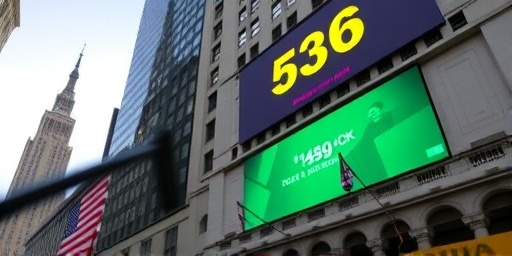In a triumphant day for Wall Street, the US Stock market shattered records as the S&P 500 and Nasdaq composite indices climbed to unprecedented levels, propelled by blockbuster tech earnings from industry leaders Nvidia and Microsoft. The surge underscores the unrelenting momentum of the AI boom, with investors shrugging off persistent inflation concerns to bet on sustained economic expansion and technological innovation.
The S&P 500 rose 1.2% to close at 5,678.45, marking its highest point ever, while the Nasdaq jumped 2.1% to 18,234.67, extending its streak of new highs. This rally, the strongest in months, was ignited by Nvidia’s announcement of quarterly revenue that exceeded expectations by 15%, largely fueled by demand for its AI chips. Microsoft’s results followed suit, revealing a 12% year-over-year increase in cloud computing revenue, highlighting the deepening integration of artificial intelligence across enterprise solutions.
Trading volume spiked to 12.5 billion shares, the highest since the Federal Reserve’s last rate decision, as optimism rippled through sectors beyond tech. The Dow Jones Industrial Average, though more subdued, gained 0.8% to end at 41,892.34, buoyed by gains in financials and industrials. This performance comes amid a broader narrative of resilience in the Stock market, where AI-driven growth narratives have overshadowed macroeconomic headwinds like sticky inflation hovering at 3.2%.
Nvidia’s AI Chip Dominance Sparks 18% Stock Jump
Nvidia, the undisputed kingpin of the AI hardware space, delivered earnings that sent its shares soaring 18% in after-hours trading, adding over $200 billion to its market capitalization in a single session. The company’s fiscal first-quarter results showed revenue of $26.04 billion, surpassing analyst forecasts of $22.6 billion. CEO Jensen Huang attributed the windfall to ‘explosive demand’ for graphics processing units (GPUs) essential for training large language models and generative AI applications.
Key highlights from Nvidia’s report include:
- Data center revenue, a proxy for AI sales, skyrocketed 427% year-over-year to $22.6 billion, accounting for 87% of total revenue.
- Gross margins expanded to 78.4%, reflecting Nvidia’s pricing power in the high-demand AI chip market.
- The company forecasted second-quarter revenue at $28 billion, well above the $27.1 billion consensus estimate.
Huang, in a post-earnings call, emphasized the AI boom’s transformative potential: ‘We’re witnessing the dawn of a new industrial revolution powered by AI, and Nvidia is at the epicenter.’ This sentiment resonated with investors, who have poured billions into AI-related stocks, viewing Nvidia as the purest play on the trend.
Historically, Nvidia’s performance mirrors the dot-com era’s tech darlings, but with more tangible profitability. Since the launch of ChatGPT in late 2022, Nvidia’s stock has quadrupled, outpacing the S&P 500’s 45% gain over the same period. Analysts at Goldman Sachs upgraded their price target to $1,200, citing ‘unabated AI infrastructure spending’ from hyperscalers like Amazon and Google.
However, not all views are unanimously bullish. Some market watchers caution about valuation risks, with Nvidia trading at a forward price-to-earnings ratio of 45 times, compared to the S&P 500’s 22. ‘While the AI boom is real, the hype could lead to a correction if growth slows,’ noted Wedbush Securities analyst Dan Ives.
Microsoft’s Azure Growth Accelerates AI Adoption Wave
Microsoft’s earnings release further amplified the tech earnings euphoria, with its stock climbing 7% to push the Nasdaq toward its record close. The software giant reported fiscal third-quarter revenue of $61.9 billion, a 17% increase from the prior year and beating estimates by $1.2 billion. At the heart of this success was Azure, Microsoft’s cloud platform, which grew 31%—double the rate of overall revenue—driven by AI workloads.
Azure’s intelligent cloud segment, encompassing AI services like Copilot and integrations with OpenAI, generated $25.9 billion, up 21%. CEO Satya Nadella highlighted the ‘rapid monetization of AI’ during the earnings call: ‘Enterprises are deploying AI at scale, and Azure is their preferred platform for this journey.’ This includes partnerships with over 65% of Fortune 500 companies embedding AI tools into workflows.
Breaking down Microsoft’s AI momentum:
- Productivity and Business Processes: Revenue here rose 15% to $19.5 billion, with Microsoft 365 commercial subscriptions up 17%, fueled by AI-enhanced features in Office apps.
- More Personal Computing: This segment, including Xbox and Surface, increased 7% to $16.5 billion, though Windows OEM revenue dipped slightly amid PC market softness.
- Capital Expenditures: Microsoft plans to invest $56 billion in AI infrastructure this fiscal year, underscoring its commitment to the boom.
The results come as Microsoft navigates regulatory scrutiny over its OpenAI stake, but investors focused on the positives. ‘Microsoft’s diversified AI exposure—from software to cloud—positions it as a safer bet than pure-play chipmakers,’ said Piper Sandler analyst Brent Thill. Shares now trade at 35 times forward earnings, a premium justified by its 20%+ projected annual growth through 2025.
Broader implications for the Stock market include Microsoft’s role in elevating the ‘Magnificent Seven’ tech stocks, which account for 30% of the S&P 500’s weight. Their collective rally today added $1.2 trillion to market value, reinforcing the index’s tech-heavy tilt.
S&P 500 and Nasdaq Break Barriers Amid Mixed Economic Signals
The record highs in the S&P 500 and Nasdaq were not isolated to tech; they reflected a broader stock market thaw. Semiconductor peers like AMD and Broadcom gained 5% and 4%, respectively, while AI-adjacent firms such as Palantir and Snowflake saw double-digit jumps. Even non-tech sectors participated: consumer discretionary rose 1.5%, led by Tesla’s 3% advance on autonomous driving AI news.
Despite inflation lingering above the Fed’s 2% target, recent data showed cooling wage growth and easing supply chain pressures, bolstering hopes for rate cuts. The PCE price index, the Fed’s preferred gauge, rose just 0.1% in May, annualizing to 2.6%. This has led to a 75% market-implied probability of a September rate cut, per CME FedWatch Tool.
Volume leaders included Nvidia (over 500 million shares traded) and Microsoft (300 million), dwarfing the S&P 500 average. The VIX ‘fear index’ dropped to 12.5, its lowest in weeks, signaling complacency. ‘The stock market is pricing in a soft landing, with AI as the growth engine,’ observed JPMorgan chief strategist Marko Kolanovic.
Year-to-date, the S&P 500 is up 15%, the Nasdaq 28%, outstripping global peers like Europe’s Stoxx 600 (up 8%). This divergence highlights America’s tech prowess, but also vulnerabilities: a potential AI bubble burst could drag indices lower, reminiscent of 2000.
Retail investors, via platforms like Robinhood, piled in with $2.5 billion in inflows to tech ETFs, per Vanda Research. Institutional flows reached $50 billion into S&P 500 funds, the largest weekly total since March.
Investor Sentiment Shifts Toward AI as Economic Growth Catalyst
As the dust settles on today’s rally, investor sentiment has decisively tilted toward the AI boom as the primary driver of economic growth. Surveys from AAII show 62% bullishness, the highest since January, with AI topping concerns over recession risks. Hedge funds, per Goldman Sachs PRIME data, increased tech exposure to 45% of portfolios, up from 35% a quarter ago.
Quotes from market luminaries capture the mood. BlackRock CEO Larry Fink stated, ‘AI will redefine productivity, much like the internet did, and today’s earnings validate that trajectory.’ Conversely, Bridgewater’s Ray Dalio warned of ‘over-optimism,’ urging diversification amid inflation’s shadow.
Global ripple effects are evident: Asian markets opened higher, with Taiwan’s TSE up 2% on Nvidia’s halo effect, while Europe’s DAX gained 1.3%. The US dollar strengthened 0.5% against a basket, as higher yields from robust growth prospects attracted capital.
Looking ahead, upcoming earnings from Amazon, Alphabet, and Meta will test the AI boom’s breadth. The Fed’s June meeting minutes, due Wednesday, could sway sentiment if they signal dovish policy. Analysts project the S&P 500 could hit 6,000 by year-end if tech earnings maintain momentum, implying 5-7% upside.
Yet, risks loom: Geopolitical tensions in the Middle East could spike energy costs, reigniting inflation. Supply chain bottlenecks for AI chips, exacerbated by US export controls on China, might cap growth. Still, the consensus is optimistic—AI investments are projected to reach $200 billion globally in 2024, per IDC, sustaining the stock market’s upward trajectory.
For investors, this environment favors selective exposure: ETFs like QQQ (Nasdaq-focused) and VGT (tech sector) have returned 25% YTD. Long-term, the AI boom could add 1-2% to US GDP growth annually through the decade, according to McKinsey estimates, cementing tech’s role in economic resilience.









